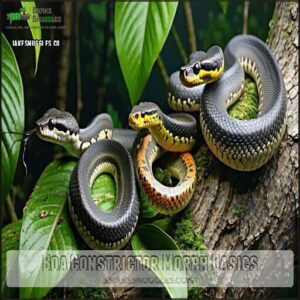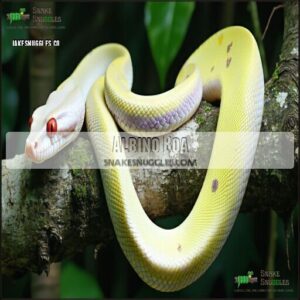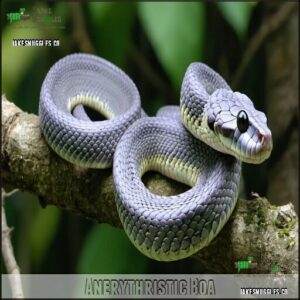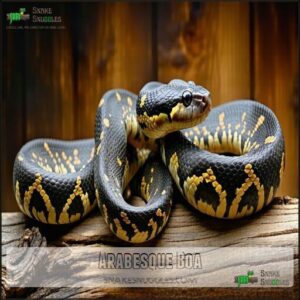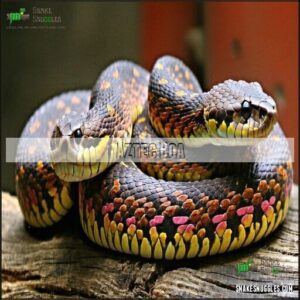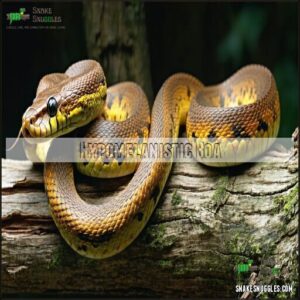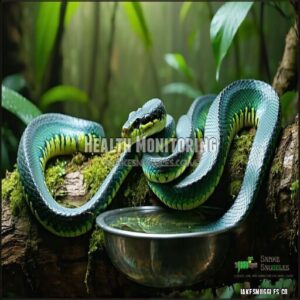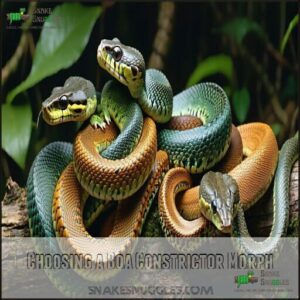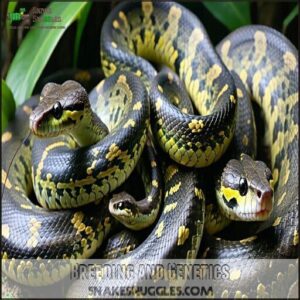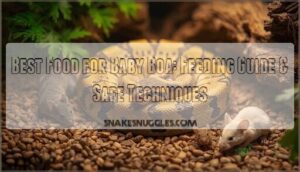This site is supported by our readers. We may earn a commission, at no cost to you, if you purchase through links.

You’ll find popular morphs like the Albino, with its bright yellows and whites, or the Anerythristic, which trades warm tones for cool grays and blacks.
Some, like the Hypomelanistic, have reduced dark pigments, while the Aztec boasts intricate, maze-like patterns.
These traits come from dominant or recessive genes, making breeding both a science and an art. Whether you’re drawn to their beauty or curious about care, each morph has unique traits worth exploring.
Curious about costs or care? Stay tuned!
Table Of Contents
- Key Takeaways
- Boa Constrictor Morph Basics
- Popular Boa Morphs
- Boa Morph Prices and Care
- Choosing a Boa Constrictor Morph
- Breeding and Genetics
- Frequently Asked Questions (FAQs)
- Do boas have morphs?
- What is the rarest species of boa?
- What are the different colors of boa constrictors?
- What is the friendliest boa constrictor?
- How do boa constrictor morphs affect lifespan?
- Are morphs more prone to health issues?
- What is the rarity of specific morphs?
- Do morphs require specialized veterinary care?
- Can morphs adapt to different climates easily?
- Conclusion
Key Takeaways
- You’ll find boa constrictor morphs with stunning colors and patterns, created by genetic mutations without changing the species.
- Understanding dominant and recessive genes helps predict morph traits, making breeding both a science and an art.
- Morph prices vary based on rarity and demand, but care costs like housing, feeding, and health monitoring are consistent.
- Ethical breeding ensures healthy boas, avoiding genetic defects while exploring unique traits and combinations.
Boa Constrictor Morph Basics
Boa constrictor morphs are genetic variations that change their colors and patterns without altering their species.
Boa constrictor morphs dazzle with stunning colors and patterns, showcasing nature’s artistry while keeping their species identity intact.
Understanding how dominant and recessive genes work helps you predict which traits might show up in their offspring.
Definition and Genetics
Morph genetics in boa constrictors revolve around genetic mutations altering their appearance, like unique colors or patterns.
These mutations, passed through trait inheritance, don’t change the species but create stunning morphs.
Snake genetics can be complex, with dominant genes needing one copy to show and recessive requiring two.
Ethical breeding and testing potential guarantee healthy, vibrant boa constrictor morphs, which is crucial for ethical breeding.
Types of Morphs
Ever wonder how boa constrictor morphs get their incredible variety?
They’re grouped into Dominant Morphs, Recessive Morphs, Combination Morphs, Regional Morphs, and Emerging Morphs.
These categories influence boa constrictor colors and patterns, from bold albinos to intricate Aztecs.
Combination Morphs, like Ghosts, blend traits beautifully, while Regional Morphs reflect unique local adaptations.
The possibilities are endlessly fascinating!
Dominant and Recessive Genes
Boa constrictor genetics can feel like a puzzle, but understanding dominant and recessive genes simplifies morph genetics.
Dominant genes show traits with just one copy, while recessive genes need two.
For example:
- Heterozygous traits carry one dominant and one recessive gene.
- Homozygous genes guarantee consistent trait expression.
- Polygenic inheritance involves multiple genes, creating stunning boa constrictor morphs with unique mutation impacts.
Ethical breeding practices avoid genetic defects.
Popular Boa Morphs
You’ll find boa constrictor morphs come in a dazzling array of colors and patterns, each with unique genetic traits.
From the striking Albino to the intricate Arabesque, these morphs showcase nature’s creativity while offering endless possibilities for enthusiasts.
Albino Boa
Albino boas, fascinating for their striking yellow bodies and red tails, showcase fascinating morph genetics.
Albino boas dazzle with vibrant yellow bodies and striking red tails, a stunning showcase of nature’s creative morph genetics.
The Albino trait, recessive by nature, requires two carrier parents for expression.
VPI Albino boas, known for purple-gray patterns, outshine Kahl and Sharp strains in color retention.
Combo morphs like Sunglow and Paradigm add vibrancy, making albino boa constrictor morphs a favorite among enthusiasts.
These snakes are popular and highly sought after by reptile keepers, with their unique characteristics making them a highly sought treasure.
Anerythristic Boa
Unlike the vibrant Albino morph, the anerythristic boa captivates with its silver bodies, lavender coloration, and saddle darkening as it matures.
This boa morph lacks red pigment due to recessive inheritance, making it a favorite in snake morphs.
Anery combinations, like Ghost or Snow, add variety, while their striking appearance and hardy nature make them perfect for dedicated enthusiasts.
Arabesque Boa
Shifting from Anerythristic boas’ silvery charm, Arabesque morphs bring bold boa constrictor patterns to the spotlight.
With intense black speckling and interconnecting saddles, their unique pairings create striking offspring.
Arabesque genetics are co-dominant, making breeding challenges exciting yet rewarding.
Identifying this boa morph is easy—look for chocolate tones with dark contrast, sometimes turning golden with age, adding allure to these enchanting boa constrictor morphs.
Aztec Boa
From the intricate Arabesque, let’s explore the Aztec morph.
Known for its striking boa constrictor patterns, this morph showcases aberrant saddles, gradient intensity, and co-dominant traits.
Aztec genetics create a unique mix of pigments, enhancing reds, yellows, and pinks.
While visually stunning, breeding potential requires caution—homozygous Aztecs often face health issues.
Morph identification explores diverse variations.
These boa morphs remain a favorite for enthusiasts.
Hypomelanistic Boa
Aztec boas wow with their bold patterns, but Hypomelanistic boas, or Hypos, shine with their reduced black pigment, giving them a softer, vibrant look.
Hypo genetics make them a favorite for breeding Hypos and creating stunning Hypo combinations. Identifying Hypos is easy—look for less black and enhanced colors.
These boa constrictor morphs are versatile, pairing beautifully with other morphs.
Boa Morph Prices and Care
Boa morph prices can range from affordable to jaw-dropping, depending on rarity and demand. While their care requirements stay consistent, understanding housing, nutrition, and health monitoring guarantees your investment thrives.
Price Factors
Boa constrictor morph prices hinge on Morph Rarity, Breeder Reputation, and Genetic Lineage.
Unique combinations or visually striking patterns often fetch higher reptile morph prices, while market demand shifts values.
Rare boa constrictor morphs like Eclipse or VPI T+ IMG/Blood can cost thousands, whereas common snake morph prices hover around $200.
Breeder care guarantees quality but adds to costs.
You can find Boa morph products online, which is influenced by Breeder Reputation and Genetic Lineage.
Cost of Care
Boa constrictor morphs don’t just come with high morph prices; their care costs add up too.
You’ll need to budget for enclosure costs, feeding expenses, heating costs, and occasional vet bills.
Long-term budgeting is key since reptile morphs require consistent care.
To properly house your boa, consider purchasing a suitable boa enclosure.
Think of it as investing in a scaly roommate who’s picky about temperature and eats rodents for dinner, which is a significant long-term commitment.
Housing and Nutrition
Boa constrictor care starts with proper housing requirements. Enclosure size should suit their adult length, exceeding four feet.
Use secure setups with ideal substrate choices for burrowing and humidity retention. Temperature control matters—snakes thrive with gradients for basking and cooling.
Consider boa enclosure products for creating an ideal habitat.
Nutrition is simple: match prey size to girth, adjust feeding frequency as they age, and avoid overfeeding to prevent obesity.
Health Monitoring
After setting up proper housing, keep an eye on health issues like respiratory infections, scale rot, or shedding problems.
Parasite prevention is key—clean enclosures regularly. Watch for obesity risks, which affect breeding and mobility.
Genetic defects or boa constrictor defects can appear; consult a vet if snake defects arise.
Healthy boas shed smoothly, breathe clearly, and maintain vibrant scales without signs of reptile defects, and parasite prevention is crucial for their health, which is linked to respiratory infections.
Choosing a Boa Constrictor Morph
When choosing a boa constrictor morph, you’ll want to balance appearance, genetics, and temperament to find the perfect match.
Understanding each morph’s traits and working with reputable breeders guarantees a healthy and stunning addition to your collection.
Researching Reputable Breeders
Finding reputable boa constrictor breeders guarantees healthy boa morphs. Look for breeders prioritizing ethical breeding and genetic testing.
Check for health guarantees and morph expertise. Avoid red flags like overcrowded enclosures or vague answers.
Trustworthy breeders should offer:
- Transparent breeding practices
- Detailed morph lineage
- Proven reptile breeding experience
- Strong breeder reputation
- Commitment to snake breeding ethics
Selecting Compatible Morphs
Choosing boa constrictor morph compatibility isn’t just about looks—it’s genetics.
Pairing morphs with dominant gene expression enhances visual trait combos, while recessive gene risks need careful planning.
Avoid genetic defects by prioritizing hybrid vigor benefits.
Use this guide:
| Morph Type | Gene Type | Breeding Tip |
|---|---|---|
| Albino | Recessive | Pair het Albinos for visuals |
| Hypo Jungle | Co-dominant | Boosts pattern vibrancy |
| IMG | Dominant | Darkens offspring dramatically |
Considering Temperament
When picking boa constrictor morphs, don’t overlook temperament—it’s like choosing a roommate.
Some morphs, like Hypo boas, are naturally docile and easy to handle, perfect for beginners.
Others might lean toward aggressive morphs, requiring more experience and careful handling techniques.
Always match the morph’s temperament to your comfort level to guarantee a stress-free relationship with your boa constrictor.
Consistent handling can improve temperament, but it’s important to recognize stress and anxiety in your boa.
Understanding Morph Characteristics
While temperament matters, understanding morph characteristics is just as important.
Boa constrictor morphs showcase unique color genetics and pattern variations, making each snake’s appearance distinct.
Some, like the IMG morph, darken with age, while others, like Albino boas, lack melanin entirely.
Combination effects and rarity factors also influence reptile appearance, so learn to visually identify traits before choosing a reptile.
Breeding and Genetics
Breeding boa constrictor morphs is all about understanding how genes interact to create unique patterns and colors.
By learning inheritance patterns and choosing compatible morphs, you can guarantee healthy offspring while exploring fascinating genetic possibilities.
Inheritance Patterns
Understanding inheritance patterns is key to breeding boa constrictor morphs.
Dominance expression means a single gene copy shows the trait, while recessive traits need two.
Mutation combinations create stunning results, but genetic testing helps uncover hidden recessive genes.
Ethical breeding guarantees healthy reptiles by respecting reptile genetics and avoiding harmful pairings.
Understanding snake genetics basics is vital for breeders, as it’s like crafting nature’s masterpiece responsibly, with a focus on healthy reptiles.
Breeding Strategies
When planning boa breeding, focus on strategies that maximize success.
Verify morph compatibility by researching traits and genetic combinations. Use genetic screening to avoid defects and maintain ethical considerations.
Keep market demand in mind, but prioritize health. Perfect your incubation techniques for consistent results.
Breeding boa constrictor morphs combines science, patience, and a little luck—like baking, but with scales!
Line Breeding and Genetic Diversity
Line breeding can refine traits like pastel colors but carries inbreeding risks, leading to genetic bottlenecks.
Outcrossing benefits include diversity maintenance and reducing genetic mutations. Dominant and recessive genes shape morph outcomes, while codominant genes create unique variations.
Balancing trait fixation with genetic diversity guarantees healthy boas. Notably, some island boa populations exhibit convergent evolution patterns, developing similar traits independently.
| Concept | Explanation | Risks | Benefits |
|---|---|---|---|
| Line Breeding | Refining traits over time | Inbreeding risks | Predictable morph traits |
| Genetic Bottlenecks | Reduced genetic variation | Health issues | None |
| Outcrossing Benefits | Introducing new genes | Less trait fixation | Diversity maintenance |
| Trait Fixation | Desired trait establishment | Limited diversity | Unique morphs |
Frequently Asked Questions (FAQs)
Do boas have morphs?
In the case of boas, variety is the spice of life.
They’ve morphs—genetic mutations that change their skin color or patterns, creating stunning looks while keeping them the same species.
Fascinating, right?
What is the rarest species of boa?
The rarest boa species is the Cropan’s boa (Corallus cropanii), found only in Brazil’s Atlantic Forest.
It’s elusive, with few sightings and limited knowledge, making it a fascinating mystery for herpetologists and enthusiasts alike.
What are the different colors of boa constrictors?
Boa constrictors show an incredible range of colors, from earthy browns and grays to striking whites, silvers, and even vibrant reds.
Their hues depend on genetic morphs, creating endless possibilities for unique patterns and vibrant shades.
What is the friendliest boa constrictor?
If boa constrictors could win personality awards, the Colombian boa would take the crown.
Known for their calm demeanor and adaptability, they’re like the golden retrievers of snakes—perfect for beginners and experienced handlers alike, showcasing their adaptability.
How do boa constrictor morphs affect lifespan?
Boa constrictor morphs don’t directly affect lifespan if bred ethically.
Poor breeding practices or genetic defects, however, can lead to health issues.
With proper care, morphs live as long as standard boas—around 20-30 years.
Are morphs more prone to health issues?
Morphs aren’t automatically prone to health issues, but poor breeding practices can amplify genetic defects.
Responsible breeders prioritize health, avoiding harmful combinations.
Think of it like crafting a recipe—bad ingredients spoil the dish, right, due to poor breeding practices?
What is the rarity of specific morphs?
Some morphs, like Eclipse or Sunset Blood, are as rare as finding a needle in a haystack.
Their rarity depends on genetic complexity, demand, and limited breeding, making them highly sought after by enthusiasts.
Do morphs require specialized veterinary care?
You don’t need a boa specialist, but finding an exotic vet familiar with reptiles is essential.
Morphs don’t require unique care, but regular checkups guarantee their health, especially since some genetic traits might affect longevity.
Can morphs adapt to different climates easily?
Adapting to different climates isn’t a breeze for boa morphs.
While their care basics stay consistent, you’ll need to tweak enclosure temperatures and humidity levels to mimic their natural tropical environment for peak health.
Conclusion
Exploring morphs of boa constrictors is like discovering a genetic treasure chest, revealing endless possibilities in color and pattern.
Whether you’re fascinated by the science of inheritance or captivated by their beauty, these snakes offer something for everyone.
Explore their care, from housing and nutrition to health monitoring, and you’ll find they’re as rewarding as they’re stunning.
With the right research and breeder, you can choose a morph that matches your style and curiosity perfectly.

